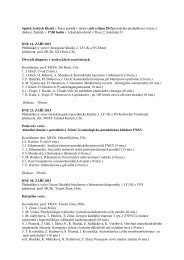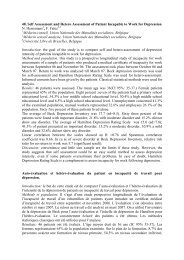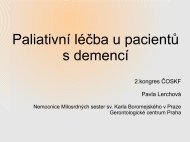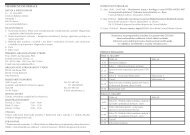ABSTRACTS â ORAL PRESENTATIONS - AMCA, spol. s r.o.
ABSTRACTS â ORAL PRESENTATIONS - AMCA, spol. s r.o.
ABSTRACTS â ORAL PRESENTATIONS - AMCA, spol. s r.o.
Create successful ePaper yourself
Turn your PDF publications into a flip-book with our unique Google optimized e-Paper software.
30. AN AUTOMATED ANALYSIS OF HIGHLY COMPLEX FLOW CYTOMETRY-BASED<br />
PROTEOMIC DATA<br />
Jan Stuchlý 1,2 , Veronika Kanderová 1,2 , Karel Fišer 1,2 , Daniela Černá 1,2 , Anders Holm 4 ,<br />
WeiWei Wu 4 , Ondřej Hrušák 1,2 , Fridtjof Lund-Johansen 4 , Tomáš Kalina 1,2<br />
1<br />
Department of Pediatric Hematology and Oncology, 2 nd Faculty of Medicine, Charles<br />
University Prague and University Hospital Motol, Prague, Czech Republic<br />
2<br />
CLIP - Childhood Leukemia Investigation Prague<br />
3<br />
Department of Numerical Mathematics, Faculty of Mathematics and Physics, Charles<br />
University, Prague, Czech Republic<br />
4<br />
Department of Immunology, Rikshospitalet Medical Center and the University of Oslo,<br />
Oslo, Norway<br />
Correspondence to: jan.stuchly@lfmotol.cuni.cz<br />
The combination of color-coded microspheres as carriers and flow cytometry as a<br />
detection platform provides new opportunities for multiplexed measurement of biomolecules.<br />
Here, we developed a software tool capable of automated gating of colorcoded<br />
microspheres, automatic extraction of statistics from all subsets and validation,<br />
normalization, and cross-sample analysis. The approach presented in this article<br />
enabled us to harness the power of high-content cellular proteomics. In size exclusion<br />
chromatography-resolved microsphere-based affinity proteomics (Size - MAP), antibodycoupled<br />
microspheres are used to measure biotinylated proteins that have been<br />
separated by size exclusion chromatography. The captured proteins are labeled with<br />
streptavidin phycoerythrin and detected by multicolor flow cytometry. When the results<br />
from multiple size exclusion chromatography fractions are combined, binding is detected<br />
as discrete reactivity peaks (entities). The information obtained might be approximated<br />
to a multiplexed western blot. We used a microsphere set with >1000 subsets, presenting<br />
an approach to extract biologically relevant information. The R-project environment<br />
was used to sequentially recognize subsets in two-dimensional space and gate them.<br />
The aim was to extract the median streptavidin phycoerythrin fluorescence intensity<br />
for all 1000+ microsphere subsets from a series of 96 measured samples. The resulting<br />
text files were subjected to algorithms that identified entities across the 24 fractions.<br />
Thus, the original 24 data points for each antibody were compressed to 1–4 integrated<br />
values representing the areas of individual antibody reactivity peaks. Finally, we provide<br />
experimental data on cellular protein changes induced by treatment of leukemia cells<br />
with imatinib mesylate. The approach presented here exemplifies how large-scale flow<br />
cytometry data analysis can be efficiently processed to employ flow cytometry as a highcontent<br />
proteomics method.<br />
Acknowledgements<br />
This work was supported by IGA NT/13462 and GAUK 596912<br />
Analytical Cytometry VII 55








